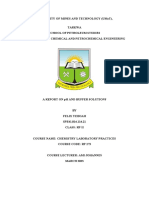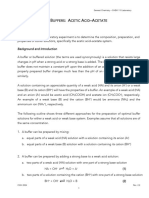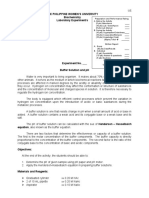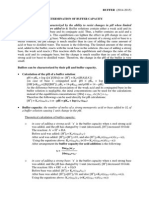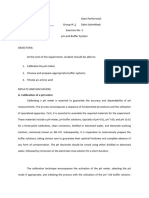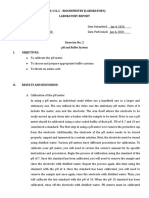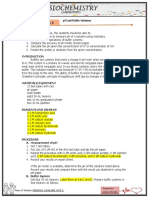Experiment-1
AIM: Preparation of solutions, pH adjustments, and buffers.
1. Preparation of Solutions
a. Weighing Solids
1. Use an analytical balance to measure the desired amount of solid reagent.
2. Transfer the reagent to a clean, dry beaker or flask.
3. Record the exact mass to ensure accuracy.
b. Dissolving Solids in Solvent
1. Add an appropriate solvent (usually distilled or deionized water) to the solid reagent.
2. Swirl the container or stir using a magnetic stirrer until the reagent is completely dissolved.
3. If necessary, warm the solution gently to help dissolve the solid (make sure the solvent is
suitable for heating).
c. Dilution of Stock Solutions
1. If you need a specific concentration from a stock solution, use the dilution formula:
C1×V1=C2×V2C_1 \times V_1 = C_2 \times V_2
Where:
o C1C_1 = concentration of the stock solution
o V1V_1 = volume of the stock solution to be used
o C2C_2 = desired concentration
o V2V_2 = final volume of the solution
2. Measure the required volume of stock solution using a pipette or burette.
3. Add it to a clean container and dilute with solvent (e.g., water) to the final desired volume.
2. pH Adjustment
a. Measuring pH
1. Use a calibrated pH meter or pH indicator paper to measure the pH of the solution.
2. Immerse the pH electrode into the solution and wait for the reading to stabilize.
b. Adjusting pH with Acid or Base
To decrease pH (make the solution more acidic):
1. Slowly add a strong acid (such as hydrochloric acid, HCl) drop by drop, while stirring
continuously.
� 2. Measure the pH after each addition and stop when the desired pH is reached.
To increase pH (make the solution more basic):
1. Slowly add a strong base (such as sodium hydroxide, NaOH) drop by drop, while
stirring.
2. Measure the pH after each addition and stop when the desired pH is reached.
Note: Always add acids and bases slowly to avoid overshooting the target pH.
3. Preparation of Buffers
A buffer is a solution that resists changes in pH when an acid or base is added. It typically consists of
a weak acid and its conjugate base or a weak base and its conjugate acid.
a. Choose a Buffer System
Select a buffer pair with a pKa close to the desired pH (within 1 pH unit).
Common buffer systems:
o Phosphate buffer: Used for a pH range of 5.8 to 8.0
o Acetate buffer: Used for a pH range of 3.6 to 5.6
o Tris buffer: Used for a pH range of 7.0 to 9.0
b. Prepare the Buffer Solution
1. Calculate the required amounts of the acid and base components based on the desired pH
and buffer concentration. The Henderson-Hasselbalch equation can help:
pH=pKa+log([A−][HA])\text{pH} = \text{pKa} + \log \left( \frac{[A^-]}{[HA]} \right)
Where:
o pKa\text{pKa} = dissociation constant of the acid
o [A−][A^-] = concentration of the conjugate base
o [HA][HA] = concentration of the weak acid
2. Prepare the acid and base components:
o Weigh the required amount of the weak acid and its conjugate base (or weak base
and conjugate acid).
o Dissolve in water to form stock solutions, as needed.
3. Mix the acid and conjugate base (or base and conjugate acid) in the desired proportions.
4. Check and adjust the pH by adding small amounts of acid (HCl) or base (NaOH) until the pH
reaches the desired value.
c. Final Adjustments
� 1. After the buffer is prepared, adjust the volume to the desired final volume with distilled
water.
2. Stir or shake the solution to ensure complete mixing.
3. Store the buffer in a clean, labeled bottle, and note the pH and concentration for future
reference.
4. Storage of Solutions and Buffers
Store solutions in clean, tightly sealed containers to prevent contamination or evaporation.
Label all containers with the name of the solution, concentration, pH (if relevant), and
preparation date.



